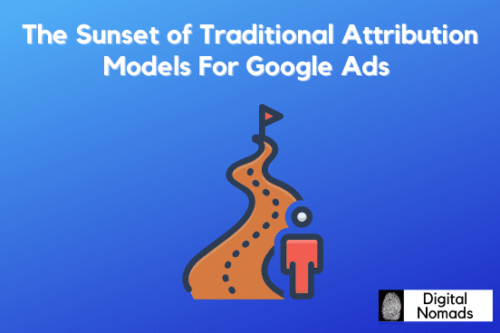
Data Driven ,The Winning Attribution Model For Google Ads
Introduction
In today’s digital age, businesses rely heavily on online advertising to reach their target audience. With the vast amount of data available, it can be overwhelming for marketers to determine which channels and campaigns are driving conversions. That’s where attribution models come into play.
Attribution models are methods used to determine which touchpoints in a customer’s journey lead to a conversion or sale. From June 2023, the data-driven attribution model for conversions will become the default option for automated bidding in Google Ads.
This powerful tool allows advertisers to allocate budgets more effectively by analysing user behaviour across multiple touchpoints. In this blog post, we’ll delve deeper into what data-driven attribution is and why it’s essential for successful digital marketing campaigns in 2023 and beyond.
What is Data-Driven Attribution?
Data-driven attribution is an advanced attribution modelling technique used in digital advertising that uses machine learning algorithms to analyse historical data and determine the contribution of each ad interaction or touchpoint in the customer journey to a conversion.
Unlike traditional attribution models that give equal credit to each touchpoint or only credit the last interaction before a conversion, data-driven attribution takes into account the influence of all interactions and assigns fractional credit based on their impact on the customer’s decision to convert. This provides a more accurate view of the effectiveness of each ad and allows advertisers to optimise their campaigns and allocate budgets more effectively.
Why is Data-Driven Attribution the ‘New’ Default Model for Google Ads?
This year, Google Ads will be shifting towards data-driven attribution as the default model for advertisers. This move reflects the increasing importance of data analytics in advertising, as well as the limitations of traditional attribution models.
From June 2023, Google Ads will no longer allow advertisers to choose linear, time-decay, position-based, or first-click attribution models for conversion actions. Any conversion actions still using these models will be automatically moved to data-driven attribution from September 2023. Google has stated that this move is due to the inflexibility of rules-based attribution models to adjust to changing consumer journeys.
Therefore, soon time-decay, linear, position-based, and first-click attribution models across Google Ads will go away. However, data-driven attribution, last click, and external attribution will not be impacted.
Say Goodbye to Guesswork: How Data-Driven Attribution is Making Google Ads More Effective
Data-driven attribution allows advertisers to gain a more precise understanding of the role each touchpoint played in a customer’s journey towards conversion. By evaluating the weight of each interaction using machine learning algorithms, data-driven attribution assigns fractional credit to every touchpoint along the way, even those that were previously undervalued by rules-based models.
This level of granularity in attribution can be immensely valuable for advertisers, as it enables them to allocate their advertising budgets more effectively. Switching to data-driven attribution from another attribution model can lead to an average 6% increase in conversions for advertisers.
The data-driven attribution model uses your account’s past data to determine how people interact with your various ads and decide to become your customers. Advertisers can use this model, alongside Smart Bidding, to make well-informed advertising decisions and increase campaign performance. Google is also bringing data-driven attribution to more advertisers and ad types, including app conversions and Discovery formats.
Using data-driven attribution paired with smart bidding has resulted in a dramatic increase in conversions for various clients at our Digital Marketing Agency, Hong Kong. We help our clients identify which ads are performing well and adjust their campaigns accordingly. Some other benefits of the data-driven attribution model that we help our clients achieve are:
1. Comprehensive understanding of advertising performance
Data-driven attribution analyses the entire customer journey and assigns credit to each touchpoint based on its impact on conversions. This allows advertisers to gain a more accurate and comprehensive understanding of their advertising performance and make more informed decisions about their campaigns.
2. Flexibility and adaptability
Unlike traditional attribution models, which rely on fixed rules, data-driven attribution uses machine learning algorithms to adjust and adapt to changing consumer behaviour and evolving marketing strategies.
3. More accurate allocation of budgets
With data-driven attribution, advertisers can optimise their investments towards those touchpoints that are driving the most conversions and revenue. By doing so, they can maximise their advertising return on investment (ROI) and generate more revenue from their ad spend.
4. Consideration of all touchpoints
Data-driven attribution takes into account all touchpoints in the customer journey, including display ads, search ads, and even offline channels like TV and radio. This allows advertisers to better understand the role of each touchpoint in driving conversions and adjust their campaigns accordingly.
5. Improved performance and effectiveness
With a more accurate and comprehensive view of advertising performance, advertisers can optimise their campaigns and improve their overall effectiveness. This can lead to better engagement, higher conversions, and ultimately, more revenue for their business.
Conclusion
In conclusion, data-driven attribution is a powerful tool that can help you achieve your marketing goals. This model helps advertisers to make more informed and efficient advertising decisions, which in turn can result in a higher return for their advertising investment.
With machine learning and automation advancements, it’s easier than ever to leverage the power of data to make informed decisions about your campaigns. By understanding which touchpoints are driving conversions and optimising accordingly, you can ensure that every dollar spent is contributing to your bottom line. So if you’re not already using data-driven attribution in your marketing strategy, now is the time to start.
Request a free consultation to discuss how our Digital Marketing Agency, Hong Kong can help your company make the most of the data-driven attribution model in Google Ads.

